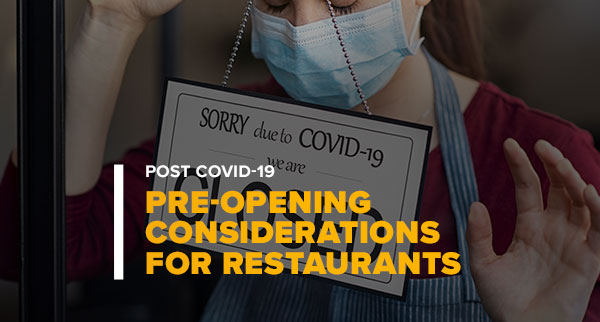#2 in the "Restaurants Post-COVID-19" series. Think back to when you first opened your restaurant. It was probably a long and arduous process filled with sleepless nights and several trips to the proverbial drawing board as you discounted old ideas for new ones. In this pandemic moment, if you’ve decided to re-open when your state or local municipality deems it appropriate, then you’re about to go through a similar process all over again but with a few added twists. You now need to account for the psychological effects of COVID-19 on your guests and staff. This is not going to be easy, just like it wasn’t simple the first time around—your actions need to be meticulously planned and executed.
Let’s look at the “pre-opening” process. And let’s be clear, this is not about simply re-opening. In the plainest terms, re-opening is turning the lights and stoves back on Tuesday morning if you’re closed on Mondays, or following a fumigation that required your closure for 48 hours. Instead, you have a much more complex set of things to take into account before opening your doors following this forced closure. It is also important to note that unlike past re-openings, the added health and safety concerns of your staff and customers will play a key role in how you approach getting ready to open. Health and safety have always been issues that need to be dealt with but the advent of social distancing and the heightened focus on sanitized items makes the planning process even more critical. And of course, the CDC guidelines must also be accounted for.
Considering Your Staff
As you get started with the pre-opening processes, one of the first and most important questions you should ask yourself is: how are you going to bring back your staff? Everyone wants things to return to a sense of normalcy, and most people want to get back to work as soon as possible. However, you will likely have some members of the staff who are more hesitant than others to return to work. These employees might live in multi-generational homes with someone who is immunocompromised, or they may now have additional childcare issues without external resources.
Your employees are going to want to know that you considered their health and safety, because they will be working not just with each other but also interacting with the general public. Communication will be key in getting a team back to work. You may want to call your employees individually and assess their level of tolerance for returning to work. But prior to making those calls, take time to consider what you will say to put each person’s mind at ease. Since you will not be starting with 100% staff capacity, these conversations can help you develop a plan for bringing employees back in waves and in a manner that is respectful of each staff member’s unique situation. More importantly, it will go a long way towards demonstrating to your staff that you care. It may seem like a big task in the midst of everything else, but we have seen some of our very large clients undertake this effort, and the goodwill and insights they received were invaluable.
Whatever safety measures you implement, it is important to communicate with your staff. For example, a quick update to your employee manual can state that there will be temperature checks for all employees entering the premises. You should also communicate plans for personal protective equipment (PPE) for staff so they see you are making every effort to keep them safe and healthy. Additionally, clarifying new cleaning and sanitizing procedures will be helpful both from the reality of the changes, as well as the perception of your staff.
Providing this reassurance means you will, of course, have to invest in PPEs for all of your staff. This will manifest in different ways depending on their level of potential exposure as well as the perception of safety you want to convey to your guests. For example, the members of your kitchen staff may only need face masks, but you may want to invest in both face masks and face shields for your FOH staff, as they will have more direct exposure to a larger number of people. In making this decision, the perception of the guest also needs to be accounted for.
Preparing the Front of House
Because your FOH is where staff interacts with guests – and guests navigate social distancing from other guests – there are a number of complexities that require forethought.
Your restrooms must be addressed in pre-opening because this is the one space shared by guests from different parties. How do you manage traffic into and out of the restroom? How do you address opening and closing doors? Do you need an automatic door or do you install a door that can swing both inward and outward? Do you hire an attendant who can also ensure that other fixtures in the restroom are wiped down? Do you approve capital expenditures to ensure that everything in your restrooms are automated: toilets, sinks, soap dispensers, paper towel dispensers, and hand-dryers? And, do you change the cleaning frequency of the restrooms if you don’t have an attendant?
As you consider the work of your FOH staff, you may need to revisit your service stations. Most service stations are in cramped corners out of the sightline of guests. Unfortunately, these do not allow for much in the way of social distancing. Do you add side stations to facilitate social distancing by your staff? Additionally, in the past, you may have left a bus bin filled with dishes in your service station but from the psychological standpoint of the guest and employee, removing used tableware to the kitchen immediately may be the best course of action. Another thing to consider is the impact on work standards with these and other adjustments.
Eating utensils are a highly sensitive element in your post-quarantine restaurant experience. If you did not previously utilize roll-ups, you probably want to start now. A roll-up on a table or handed to a guest with a gloved hand will put their mind at ease more so than utensils simply left on a table. Committing to roll-ups means determining not only how to get the work done in a sanitary manner, but also how you will store the bundles—you’ll probably need a system with covered bus bins or Lexan so the roll-ups are not exposed to open air. If your FOH staff are required to use gloves, you will need to ensure you include guidelines for accessing your roll-up bins when you are training staff on glove and service protocols.
Once you’ve determined your solution for eating utensils, you will have to turn your attention to glassware. Will you give your guests water and wine glasses upon sitting down or will you have your staff set the tables beforehand with the glasses? Will you deliver a carafe or pitcher of water that your guests can pour themselves or will they still be comfortable with a busser pouring water for them? If you decide to use a pitcher or carafe, your staff must be trained to properly clean and sterilize the vessel when guests get up from the table. We’ve probably all witnessed FOH staff dump a carafe of water after clearing it from a table, only to watch them immediately refill it for new guests. It should not have been acceptable before, and it certainly won’t be permitted moving forward. Vigilance and training will be the keys to success.
One more thing to consider before we turn our attention to the back of house, is your menu. Not simply what will be on it, although this is of utmost importance, but the form it will take. Your menu could be printed on paper and easily disposable. Alternatively, it could be placed on every table underneath a piece of plexiglass for your guests to read. This second option would significantly reduce the amount of paper waste generated by your business, which is worthy of consideration when expenses will almost assuredly be higher. A third option is to eliminate physical menus by switching to an online platform. With almost 80% of Americans using smartphones almost every guest will have one, so you could consider having your entire menu available online if you don’t already. This would then entail clearly communicating to your guests that they can refer to your menu online while in your restaurant. You may even be able to use a geotagged QR Code so a guest can place an order directly from their phone; this order would then only have to be confirmed by a server. This is a concept worth further exploration, but for now, let us turn our attention to the kitchen.
Managing the Back of House
Social distancing is incredibly difficult in a restaurant kitchen on a good day. The fact more people aren’t constantly bumping into each other is a testament to the dance that is the kitchen. So, in an effort to keep members of your kitchen staff—and by extension the general public—safe, there are some things that can be changed and improved in a post-pandemic kitchen.
One relatively quick fix is to stagger in-times for prep cooks. If you previously had four or six cooks who all arrived for their shift at 10 in the morning, consider bringing half in at 8am and the other half at 10am. Additionally, you will have to define work patterns that enable your cooks to maintain social distancing. This is probably easier during prep hours but could be incredibly difficult during service and may require certain menu adjustments. Our next article in this series will dive more deeply into menu engineering, but it should definitely be on your radar during pre-opening.
This is also a perfect time to think about efficient consolidation of your kitchen operations and even a review of service delivery processes, looking for ways to distance or even reduce staff at certain times. This could be especially important as you will be opening at reduced capacity. If spacing considerations need to be taken into account, a team of fully cross-trained staff can be very effective in handling multiple responsibilities without the need for work “silos”. A smaller team of people will allow you to save on labor while adhering to social distancing.
In addition to the social distancing in your kitchens, you may want to make sure you have a dedicated expeditor who never leaves the pass-through. In the past, some restaurants have employed a runner who also functioned as the expeditor, but this maximizes the potential exposure of that person and by extension everyone they come into contact with. If instead you treat your expeditor like he or she is in a fine dining restaurant, then that person would execute the standards by wiping down every plate and potentially putting a cloche on it before it left the kitchen.
A cloche is a great example of a way to demonstrate to your guests that you are taking their safety seriously. If every plate of food leaves your kitchen covered and is only uncovered by a server or runner with a gloved hand when it reaches a table, the psychological impact from the guest perspective could be enormous.
The pre-opening process and strategies may appear to be complex, but an effective plan that is executed meticulously can spell the difference between success and failure. Taking the time to think through all the details and follow all the lines of inquiry is the best way to ensure the most successful and smooth re-opening as well as sustainability. Effective staff training in all of the new processes and procedures, both from the employee and guest perspective, will be key. And remember that while you can plan for almost any eventuality, it is still the restaurant industry and you have to be ready for anything.
-
Read the other articles in the series:
- #1: Operating Restaurants in a COVID-19 Environment
- #2: Pre-Opening Considerations for Restaurants in a COVID-19 Environment
- #3: Menu Engineering and Planning
- #4: Taking Full Advantage of Available Demand with Post COVID-19 Restricted Restaurant Capacity
- #5: Managing the Back of the House in Post-COVID-19 Re-Opening
- #6: Operating in the New COVID-19 Normal






